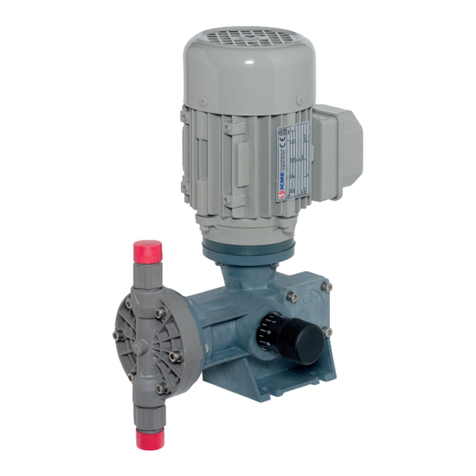8.1 –Pulsation dampener ............................................................................................................................... 34
8.2 - Pressure gauge ....................................................................................................................................... 34
8.3 - Safety relief valve.................................................................................................................................... 34
8.4 - Sampling or draining............................................................................................................................... 34
8.5 - Filter ....................................................................................................................................................... 34
8.6 - Flowmeter............................................................................................................................................... 34
8.7 - Back pressure valve................................................................................................................................. 35
8.8 - Shut-off valve in the discharge pipe......................................................................................................... 35
9 - LUBRICATION.................................................................................................................................................... 35
10 - ELECTRICAL CONNECTION............................................................................................................................... 36
10.1 -MOTOR CONNECTION ..................................................................................................................................... 36
11 - PUMP ADJUSTMENT ....................................................................................................................................... 37
11.1 -STROKE VARIATION WITH MANUAL SYSTEM .......................................................................................................... 37
11.2 -STROKE VARIATION WITH SERVO CONTROL ........................................................................................................... 37
12 - OPTIONAL ACCESSORIES.................................................................................................................................38
12.1 -CONTROL WITH INDUCTIVE PROXIMITY SENSOR ..................................................................................................... 38
13 - PROCEDURE BEFORE START-UP ...................................................................................................................... 38
13.1 -COMMISSIONING ...........................................................................................................................................38
13.2 -PROBLEMS UPON COMMISSIONING .................................................................................................................... 38
14 - MAINTENANCE................................................................................................................................................ 39
14.1 –PUMP MAINTENANCE,REPAIRS.........................................................................................................................39
14.2 -PROCEDURES FOR MAINTENANCE INTERVENTION ...................................................................................................39
14.3 -RESIDUAL RISKS ............................................................................................................................................. 40
14.4 -SPARE PARTS LIST...........................................................................................................................................40
14.5 -PREVENTIVE MAINTENANCE..............................................................................................................................40
14.5.1 - Noisy mechanics with vibrations ........................................................................................................ 40
14.5.2 - Electric motor..................................................................................................................................... 40
14.5.3 - Checking the flexible coupling ............................................................................................................ 40
14.5.4 - Checking the pump flow rate.............................................................................................................. 41
14.5.5 - Pressure ............................................................................................................................................. 41
14.6 -ROUTINE MAINTENANCE..................................................................................................................................41
14.7 -VALVE UNIT CLEANING .................................................................................................................................... 41
15 - MAINTENANCE OF DOSING PUMP HEADS ...................................................................................................... 42
15.1- MAINTENANCE OF PISTON PUMP HEADS A............................................................................................................42
15.1.1 - Piston seal check and replacement..................................................................................................... 42
15.1.2 - Pump head with gasket washing........................................................................................................ 42
15.1.3 - Replacement of the "PTFE" gasket pack ............................................................................................. 43
15.1.4 - adjustment and compression of "PTFE" gaskets ................................................................................. 43
15.1.5 - Intermediate maintenance................................................................................................................. 43
15.2 -MAINTENANCE OF DIRECT DIAPHRAGM PUMP HEADS TYPE D....................................................................................44
15.3 -MAINTENANCE OF TYPE BHYDRAULIC DIAPHRAGM PUMP HEADS .............................................................................. 45
15.3.1 - Operations to be performed on the Type B pump head....................................................................... 45
15.3.2 - Pump head disassembly and diaphragm replacement........................................................................ 45
15.3.3 - Piston disassembly and reassembly.................................................................................................... 45
15.3.4 - Filling the oil reservoir ........................................................................................................................ 46
15.4.5 - Routine maintenance ......................................................................................................................... 47
15.4 -MAINTENANCE OF TYPE BR HYDRAULIC DIAPHRAGM PUMP HEADS ............................................................................48
15.4.1 - Operations to be performed on the Type BR pump head .................................................................... 48
15.4.2 - Recirculation vessel calibration and oil filling ..................................................................................... 48
15.4.3 - Pump head disassembly and diaphragm replacement........................................................................ 49






























